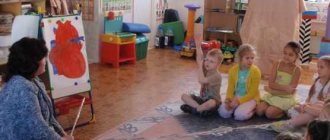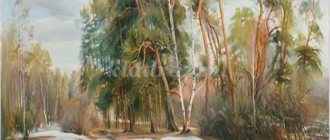Methods of introducing preschoolers to the objective world
An important place in enriching children's vocabulary is occupied by special classes to familiarize themselves with the objective world . Their main goal is to introduce into children’s speech the names of objects , their parts, some signs, properties and qualities. Children learn to identify the qualities and properties of objects , their purpose, and then generalize them into conceptual groups.
The methodology for these classes was proposed by E. I. Tikheeva and clarified and supplemented by V. I. Loginova. The authors identify 3 groups of classes to familiarize themselves with the subject world :
1- initial familiarization with the subject .
2 - familiarization with the qualities and properties of objects .
3 - formation of concepts in the process of generalizations.
Initial familiarization with objects - introducing new names of objects into the dictionary and actions with them . Conducted in younger and middle ages.
Meaning:
1. A holistic idea of the subject
2. The connection between the purpose of an object , its structure, and material.
Requirements for these classes:
1. Cognitive activity is represented by practical tasks and is based on gaming techniques.
2. Use of visual material according to the number of children.
3. Active actions with objects , children choose suitable ones and motivate the choice.
4. Objects must be known to children.
5. Leadership is provided through instructions and questions.
Lesson structure.
The introductory and final parts are similar to other lessons.
Main part
1. Statement of the educational task ( the formation of differentiated perception is carried out through the game).
2. Examination of the subject , structure, purpose, introduction of words.
3. Children’s choice of subject , consolidation of knowledge, consolidation of words.
In classes to deepen knowledge about the qualities and properties of objects holistic understanding of the object : a connection is established between the purpose of the object and its structure , the material from which it is made, and the specific features of the object are determined .
Meaning:
1. The concept is formed that all things are made of different materials; there are processes that transform material into a thing (sewing, knitting, modeling, woodworking, etc.)
2. The ability to see material in a thing is formed, to establish the properties of the material in some ways (press, bend, tear)
.
Requirements
1. Thorough sensory examination.
2. Visual material on the number of children.
3. Inclusion in activities.
4. The qualities being isolated must be clearly presented .
5. Comparison with other qualities and properties of other objects .
6. The teacher’s guidance is carried out through questions and precise instructions.
Lesson structure
2.2.1 The introductory and final parts are similar to other lessons.
2.2.2 Main part
1. Isolating qualities in the situation of a particular activity (first indicating the action, then asking the children)
.
2. Teaching research actions to isolate the desired property (first indicate the action, a question of a stating and indirect nature (Strong paper, why)
.
3. An exercise in identifying a new quality and property in a variety of objects - consolidating properties.
Complication - at an older age, these classes become more complicated, they are called “Comparison of objects "
their goal is to select the most accurate word to characterize the highlighted features.
Requirements
1. A sufficient number of compared characteristics (shape, size, color, their differences and commonality.
2. Planned comparison of the whole, parts and details, generalization as a whole.
3. Selection of teaching methods - instructions and questions.
4. Maximum speech activity of children.
Formation of specific and generic concepts in the process of generalization.
Classes are held in all age groups. the same essential features in different objects There are two types of these activities - the formation of specific and generic concepts.
Species concepts are objects of the same type with minor differences, for example: chair, stool, armchair.
Lesson structure
The introductory and final parts are similar to other classes.
Main part
1. The need for choice through the game.
2. Selecting an item from a group of similar ones (how did you find out? Why did you take this item and not another? What does this item that others don’t (and vice versa? After each answer - motivation - Why do you think so?
3. Exercise in choosing objects .
Generic concepts - objects of different types , but united by one purpose (dishes, transport, furniture, etc.)
Lesson structure
The introductory and final parts are similar to other classes.
Main part
1. Consideration of 3-4 types, highlighting known features (what is the car for, who drives it)
2. Work on the concept ( definition of an essential feature, generalization of a group of 3-4 types and introduction of the word generalization (we highlight what is the same and what is different for all types and conclude: everything that is used to transport people and cargo is called transport)
3. An exercise in subsuming specific concepts under generic ones.
Subsequent work is based on consolidation and differentiation of concepts.
2) TRIZ is a technique that teaches you to solve various kinds of inventive problems in the most productive, simple and fast ways. Developed in 1946 by Heinrich Saulovich Altshuller. It was originally created to help find solutions to technical problems and contributed to the development of thinking, flexibility, consistency, logical construction and originality.
we can safely talk about the universality of the theory of solving inventive problems, because, first of all, it teaches us to think creatively, unconventionally and boldly.
In this regard, the use of TRIZ in kindergarten is a unique opportunity, with the help of a high-quality multifunctional tool, to solve the tasks that were assigned by the Ministry of Education of the country to teachers in preschool educational institutions.
The goals of TRIZ are not just to develop the imagination of children, but to teach them to think systematically, with an understanding of the processes taking place, to give educators a tool for specific practical education in children of the qualities of a creative personality, capable of understanding the unity and contradiction of the world around them, and solving their small problems.
The starting point of the TRIZ concept in relation to a preschooler is the principle of natural conformity of learning. When teaching a child, the teacher must follow his nature.
TRIZ for preschoolers is a system of collective games and activities designed not to change the main program, but to maximize its effectiveness.
make your own solutions.
Within the framework of the DOU, TRIZ defines the following functions:
· Teaching children competent principles for solving various creative problems.
· Training in independent work.
· Formation of creative individuals who can find non-standard answers to any questions.
· Training to work effectively in groups.
· Training in forecasting certain situations, etc.
One of the main advantages of TRIZ technology is the maximum emphasis on student independence. A minimum of theory that needs to be memorized, a minimum of direct help from the teacher. The point is that the child can reach the correct answer himself. The teacher acts as a wise mentor who directs the flow of thought of his little charges in the right direction. Algorithm for solving inventive problems
The main means of working with children is pedagogical search.
The teacher should not give ready-made knowledge, reveal the truth to him, he should teach him to find it. If a child asks a question, there is no need to immediately give a ready answer. On the contrary, you need to ask him what he himself thinks about it. Invite him to reasoning. And with leading questions, lead the child to find the answer himself. If he does not ask a question, then the teacher must indicate the contradiction. Thus, he puts the child in a situation where he needs to find an answer, i.e. to some extent repeat the historical path of knowledge and transformation of an object or phenomenon. At the first stage, children are introduced to each component separately in a playful way. This helps to see contradictions in the surrounding reality and teach them to formulate them.
Game “Yes-No” or “Guess what I wished for”, Game “Black and White”, Game “On the contrary” or “reversals”
TRIZ methods and techniques:
1.Controversies: Resolution
contradictions are the key to
creative thinking.
At the first stage the following games are used:
“Good and bad”, “On the contrary”, “Chain of contradictions”, “But”, “Sabotage approach”.
At the second stage, games with contradictions are offered to find external and internal resources
Summary of GCD in the senior group on the topic “Our smart assistants”
Summary of direct educational activities in the senior group on the topic “Our smart helpers”
Author: Natalya Mikhailovna Golyshevskaya, senior teacher of the MBDOU “Kindergarten No. 12” of a general developmental type in Barnaul Description of the material: I offer you a summary of direct educational activities for children of the senior group (5- 6 years old) on the topic “Our smart assistants” This material will be useful to teachers of older groups. Integration of educational areas “Cognition”, “Communication”, “Health”, “Socialization”, “Safety” Goal: to develop cognitive interest in a person. Objectives: Educational:
to consolidate children’s ideas about the structure of the human body, about the basic human senses and their meaning.
Developmental:
develop attention, thinking, articulatory motor skills, tactile sensations, auditory and visual perception.
Speech:
expand vocabulary, develop children’s coherent speech.
Educational:
to form a value-based attitude of children towards their own body.
Demonstration material: illustrations depicting a person without ears, eyes, nose, mouth, children's musical instruments (tambourine, rattle, whistle, bell). Handouts: dummies of vegetables and fruits, jars with the smells of garlic, onion, tangerine, slices of lemon, pickled cucumber, chocolate slices. Equipment: medical gown, cap, glasses, suitcase, pouch, markers. Methodological techniques: finger gymnastics, game exercises, looking at illustrations, physical education, pure language, breathing exercises. Progress of the GCD Teacher: All the children gathered in a circle. I am your friend and you are my friend. Let's hold hands tightly and smile at each other. — Guys, today Doctor Pilyulkin from Flower City came to visit us. Doctor Pilyulkin: Hello, guys! My friend Dunno drew portraits of this cute boy. Don't you think they are somehow strange? Looking at illustrations.
— Is there something missing in each portrait?
What? (The head is missing ears. The face is missing eyes, nose, mouth). - Eyes, nose, ears, mouth - these are our “smart” assistants. And today we will find out how they help a person. But first I'll check how attentive you are. Game “Nose-Ear-Nose” With the index finger of his right hand, Dr. Pilyulkin touches his nose and at the same time says: “Nose.” Then he touches his ear and says: “Ear.” Thus, he touches different areas of the face, naming them. Children must follow what the presenter says and do it without paying attention to his actions. Then the words quickly sound: “Noc – nose – nose – ear – eye!” At some point, Dr. Pilyulkin points to his chin and says: “Forehead.” Many children unwittingly repeat the movement after him, ignoring the words. Doctor Pilyulkin: I brought a suitcase with me, which contains a lot of interesting things (takes out a bag from the suitcase). — There are different objects in this bag, try to guess what is in there. Game “Wonderful Bag” Children take turns determining by touch what is in the bag, take out the object, and name it. Doctor Pilyulkin: How did you determine the contents of the bag? (using hands) - Why do people need hands? (with the help of our hands we dress, hold objects, draw, etc.) - Hands are also our main helpers. Educator: In order for us to be healthy, we need to be friends with our fingers! Finger gymnastics Here are my assistants, turn them any way you want. If you want it this way, if you want it this way, they won’t be offended in any way. Actions are carried out in accordance with the text Doctor Pilyulkin: Guys, look carefully at the objects that you took out of the bag. What color are they? (Tomato - red, lemon - yellow, cucumber - green, etc.) - How did you determine the color of the objects? (using the eyes) - Why do people need eyes? (With the help of the eyes, a person sees objects, their colors, shapes, sizes. The eyes help a person move in the right direction, etc.) The eyes are completed in the portrait. Dr. Pilyulkin: What should we do to keep our eyes healthy? (Take care of your eyes, train them - do eye exercises, eat foods containing vitamins, etc.) Educator: And now eye exercises so that your eyes can rest. Fizkul The plane is flying by, I was getting ready to fly with it. They look up and follow the flying “plane” with their finger
. He moved the right wing and looked. He moved the left wing and looked.
They move their right and left hands away alternately and follow him with their gaze.
I start the engine and look carefully.
They make rotational movements with their hands and follow them with their hands.
I rise up, I fly, I don’t want to return.
They stand on their toes and pretend to be in flight. Doctor Pilyulkin: There is something edible in my suitcase. Try to guess what, but to do this you need to close your eyes. Children taste foods: slices of lemon, pickled cucumber, chocolate slices and determine what it is and what taste it has (sour, salty, sweet)
- How did you determine what these foods are and what they taste like?
(With the help of language) - So, language is another of our assistants. The mouth is completed in the portrait. Educator: Let's play with our tongue. I'll start for us, and you continue. Sha-sha-sha - I have...noodles. Sa-sa-sa - a wasp flew to us. If only there were pillars in the yard. Ta-ta-ta – hot...stove. Dr. Pilyulkin: I brought with me these mysterious jars with the smell. Try to guess whose smell is “hidden” in each of them. Game “Guess by smell” Children identify the product (garlic, onion, tangerine) and name it.
- How did you guess what was in the jars?
(Using the nose) The nose is completed in the portrait. - Why does a person need a nose? (To breathe; the nose protects our body from dust and germs, etc.) - And it is also needed in order to speak beautifully. Pinch the spout with your fingers and repeat no-na. What happened? Now tell me ma-ma. Educator: We also need to take care of our nose, because it helps us so much. Breathing exercises: 1. Inhale deeply and exhale for a long time through the nose. Mouth closed. 2. Inhale through the nose, exhale through the mouth. Dr. Pilyulkin: And there are wonderful things in my suitcase. Now you will hear them. Children, sitting with their backs, guess the sounds of a tambourine, rattle, whistle, bell.
- How did you hear sounds?
(using ears) Ears are added to the portrait. — How should you take care of your ears? (wash, clean, put on a hat if it’s cold, etc.) Doctor Pilyulkin: Look at what a wonderful portrait we got!
Game “Guess what it is” Breathing, sniffing -... nose. Breathes, eats, speaks -... mouth. They work, sew, write, draw -... hands. They listen, they hear - ... ears. They see, they look - ... the eyes. - So we found out what irreplaceable helpers a person has, so take care and protect them. The teacher notes the children who were the most active.
We recommend watching:
Summary of a lesson in the senior group with a compensatory focus for children with severe speech impairments Summary of educational activities in the senior group on the topic: “Expedition to the taiga”
Synopsis of an integrated GCD in the senior group “Chest of Health” Synopsis of GCD in the senior group “Journey to a Fairy Tale”
Similar articles:
Summary of GCD for the senior group of kindergarten
Cognitive lesson in the senior group
Summary of GCD in the senior group. Excursion into nature
Summary of educational activities on cognitive development with elements of experimentation in the senior group
Abstract of GCD in the senior group on the topic: “Mathematics - Logic”




